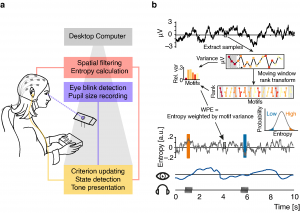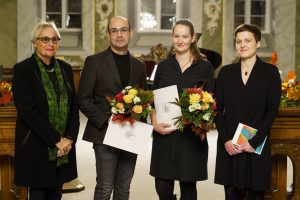New PhD opportunity: @bjoherrmann (Rotman Research) and @ObleserLab at @UniLuebeck, Germany, have a @dfg_public-funded 3‑year PhD position! (neural dynamics, temporal expectation, ageing). Apply now until July 12! Please RT widely/alert your MSc/RAs. https://t.co/gphGf8Xx4c pic.twitter.com/GneEmTGvaP
— Jonas Obleser (@jonasobleser) June 26, 2020
Congratulations to Obleserlab postdoc Julia Erb for her new paper to appear in eLife, “Temporal selectivity declines in the aging human auditory cortex”.
It’s a trope that older listeners struggle more in comprehending speech (think of Professor Tournesol in the famous Tintin comics!). The neurobiology of why and how ageing and speech comprehension difficulties are linked at all has proven much more elusive, however.
Part of this lack of knowledge is directly rooted in our limited understanding of how the central parts of the hearing brain – auditory cortex, broadly speaking – are organized.
Does auditory cortex of older adults have different tuning properties? That is, do young and older adults differ in the way their auditory subfields represent certain features of sound?
A specific hypothesis following from this, derived from what is known about age-related change in neurobiological and psychological processes in general (the idea of so-called “dedifferentiation”), was that the tuning to certain features would “broaden” and thus lose selectivity in older compared to younger listeners.
More mechanistically, we aimed to not only observe so-called “cross-sectional” (i.e., age-group) differences, but to link a listener’s chronological age as closely as possible to changes in cortical tuning.
Amongst older listeners, we observe that temporal-rate selectivity declines with higher age. In line with senescent neural dedifferentiation more generally, our results highlight decreased selectivity to temporal information as a hallmark of the aging auditory cortex.
This research is generously supported by the ERC Consolidator project AUDADAPT, and data for this study were acquired at the CBBM at University of Lübeck.
Wöstmann, Lui, Friese, Kreitewolf, Naujokat and Obleser demonstrate that the vulnerability of working memory to auditory distraction is rhythmic.
Previous research has shown that the attentional sampling of target stimuli is rhythmic at ~3–8 Hz (e.g. Fiebelkorn et al. 2013; Landau & Fries, 2012). In the present study, Malte Wöstmann and colleagues tested to what extent the suppression of distractor stimuli would be rhythmic, as well. Indeed, two measures of distraction – memory recall accuracy and the distractor-evoked N1 ERP component – were periodically modulated at slow frequencies (~2–4 Hz) by the temporal onset of a distracting speech stimulus.
In a follow-up experiment, the rhythmic distractibility could be replicated: In a visual match-to-sample task, memory recall accuracy was periodically modulated at ~2.75 Hz by the onset of a distracting noise stimulus during memory retention.
The paper is available here.
For a preprint of the paper, see.
There is now an opening for an up-to-4-year (!) postdoc position in my lab for late summer/fall. Join us in Lübeck, Germany, and do cool behavioural and neuroscience on neural dynamics, ageing, sensory decline with us!
The application deadline (as single PDF to the email address named in the add!) is June 7 2020, see German and English PDFs for all details.
Feel free to ring me up any time if you are interested in chatting beforehand. Looking forward to many interesting applications!
— J.O.
Obleserlab senior PhD student Leo Waschke, alongside co-authors Sarah Tune and Jonas Obleser, has a new paper in eLife.
The processing of sensory information from our environment is not constant but rather varies with changes in ongoing brain activity, or brain states. Thus, also the acuity of perceptual decisions depends on the brain state during which sensory information is processed. Recent work in non-human animals suggests two key processes that shape brain states relevant for sensory processing and perceptual performance. On the one hand, the momentary level of neural desynchronization in sensory cortical areas has been shown to impact neural representations of sensory input and related performance. On the other hand, the current level of arousal and related noradrenergic activity has been linked to changes in sensory processing and perceptual acuity.
However, it is unclear at present, whether local neural desynchronization and arousal pose distinct brain states that entail varying consequences for sensory processing and behaviour or if they represent two interrelated manifestations of ongoing brain activity and jointly affect behaviour. Furthermore, the exact shape of the relationship between perceptual performance and each of both brain states markers (e.g. linear vs. quadratic) is unclear at present.
In order to transfer findings from animal physiology to human cognitive neuroscience and test the exact shape of unique as well as shared influences of local cortical desynchronization and global arousal on sensory processing and perceptual performance, we recorded electroencephalography and pupillometry in 25 human participants while they performed a challenging auditory discrimination task.
Importantly, auditory stimuli were selectively presented during periods of especially high or low auditory cortical desynchronization as approximated by an information theoretic measure of time-series complexity (weighted permutation entropy). By means of a closed-loop real time setup we were not only able to present stimuli during different desynchronization states but also made sure to sample the whole distribution of such states, a prerequisite for the accurate assessment of brain-behaviour relationships. The recorded pupillometry data additionally enabled us to draw inferences regarding the current level of arousal due to the established link between noradrenergic activity and pupil size.
Single trial analyses of EEG activity, pupillometry and behaviour revealed clearly dissociable influences of both brain state markers on ongoing brain activity, early sound-related activity and behaviour. High desynchronization states were characterized by a pronounced reduction in oscillatory power across a wide frequency range while high arousal states coincided with a decrease in oscillatory power that was limited to high frequencies. Similarly, early sound-evoked activity was differentially impacted by auditory cortical desynchronization and pupil-linked arousal. Phase-locked responses and evoked gamma power increased with local desynchronization with a tendency to saturate at intermediate levels. Post-stimulus low frequency power on the other hand, increased with pupil-linked arousal.
Most importantly, local desynchronization and pupil-linked arousal displayed different relationships with perceptual performance. While participants performed fastest and least biased following intermediate levels of auditory cortical desynchronization, intermediate levels of pupil-linked arousal were associated with highest sensitivity. Thus, although both processes pose behaviourally relevant brain states that affect perceptual performance following an inverted u, they impact distinct subdomains of behaviour. Taken together, our results speak to a model in which independent states of local desynchronization and global arousal jointly shape states for optimal sensory processing and perceptual performance. The published manuscript including all supplemental information can be found here.
I am honoured to have been asked to join the editorial board of eLife, a journal I very much honour for their fresh approach to excellent scientific publishing.
eLife is a publishing initiative by the Max Planck Society, the Wellcome Trust, and Howard Hughes Medical Institute.
My tenure as reviewing editor has started December 2019.
Fotos: Guido Kollmeier, Rechte: Universität zu Lübeck.





